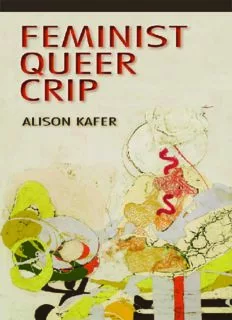
Feminist, Crip, Queer PDF
Preview Feminist, Crip, Queer
Feminist, Queer, Crip Feminist, Queer, Cr ip Alison Kafer indiana university press Bloomington and indianapolis This book is a publication of indiana university press 601 north morton street Bloomington, indiana 47404–3797 usA iupress.indiana.edu Telephone orders 800–842–6796 Fax orders 812–855–7931 © 2013 by Alison Kafer All rights reserved no part of this book may be reproduced or utilized in any form or by any means, electronic or mechanical, including photocopying and recording, or by any information storage and retrieval system, without permission in writing from the publisher. The Association of American university presses’ resolution on permissions constitutes the only exception to this prohibition. A shorter version of chapter 3 was published as “Debating Feminist Futures: slippery slopes, Cultural Anxiety, and the Case of the Deaf Lesbians,” in Feminist Disability Studies, ed. Kim Q. Hall (Bloomington: indiana university press, 2011), 218–41, and is reprinted with permission. portions of chapter 6 appeared in much earlier form as “Hiking Boots and Wheelchairs: ecofeminism, the Body, and physical Disability,” in Feminist Interventions in Ethics and Politics, ed. Barbara Andrew, Jean Keller, and Lisa H. schwartzman (Lanham, mD: rowman and Littlefield, 2005), 131–50, and are also reprinted with permission. ∞ The paper used in this publication meets the minimum requirements of the American national standard for information sciences— permanence of paper for printed Library materials, Ansi Z39.48–1992. manufactured in the united states of America Cataloging-in-publication Data is available from the Library of Congress. isBn: 978-0-253-00922-7 (cloth) isBn: 978-0-253-00934-0 (paper) isBn: 978-0-253-00941-8 (ebook) 1 2 3 4 5 18 17 16 15 14 13 For Dana Contents Acknowledgments ix textual Description of the Cover Art xiii introduction: imagined Futures 1 1 time for Disability studies and a Future for Crips 25 2 At the same time, Out of time: Ashley X 47 3 Debating Feminist Futures: slippery slopes, Cultural Anxiety, and the Case of the Deaf Lesbians 69 4 A Future for Whom? passing on Billboard Liberation 86 5 The Cyborg and the Crip: Critical encounters 103 6 Bodies of nature: The environmental politics of Disability 129 7 Accessible Futures, Future Coalitions 149 Appendices 171 notes 179 Bibliography 225 index 253 Acknowledgments i cannot begin to thank Katherine sherwood enough for letting me use her mag- nificent painting, Vesalius’s Pump, for the cover of this book. (A description of the painting immediately follows these acknowledgments.) i first saw this painting during a 2007 show of sherwood’s work at the university of California, Berkeley, and i began at that moment to hope that it might one day grace the cover of this book. i am deeply grateful that Katherine gave me permission to use it; her work has been and continues to be an inspiration to me, in all the best senses of that word. This book began as a dissertation at Claremont Graduate university, and i hope my early mentors can still see their influences on it and on me; i continue to feel the benefits of their guidance. Thanks to rosemarie Garland-Thomson, ranu samantrai, Karen Jo torjesen, and peggy Waller for pushing me to think more critically and more carefully; i am equally grateful for their willingness to help me imagine an academic career for myself. may all graduate students be so lucky. i was lucky as well in having a solid group of graduate school writing buddies: Dana newlove, sara patterson, and Zandra Wagoner. That stage of this project would have been much more difficult, and much less enjoyable, without them. it is no exaggeration to say that i could not have written this book without the generous support of the women’s studies department at the university of California, santa Barbara. By bringing me to uCsB for a dissertation fellowship, they provided me with the time and space to think through the early stages of this project. more impor- tantly, they introduced me to a staggeringly smart and insightful group of graduate students who embodied exactly the kind of engaged scholarship i describe in these pages. For helping me to see, think, and feel differently, thanks to Karl Bryant, ted Burnes, simone Chess, sharon Doetsch, Dana Collins, Beth Currans, Laura Hill- Bonnet, Jessi Quizar, matt richardson, Jeanne scheper, molly talcott, and tiffany Willoughby-Herard. For building the kind of academic programs and spaces in which such students could thrive, thanks to Jacqueline Bobo, sharon Hoshida, eileen Boris, Lou Anne Lockwood, Laury Oaks, and Leila rupp. my postdoctoral year at uC Berkeley was equally transformative; i cannot heap enough praise on the people and ideas behind the ed roberts postdoctoral Fellow- ship in Disability studies. Being able to think and talk through this project with the extended ed roberts group (Fred Collignon, Anne Finger, Lakshmi Fjord, Laura Her- shey, Devva Kasnitz, Corbett O’toole, sue schweik, and russell shuttleworth) was a dream come true, as was having the fellowship at the same time as ellen samuels and robin stephens. i am equally grateful to the fellowship for providing me the opportu- nity to expand my circle of disability comrades. Getting to work, think, and play with ix
Description: